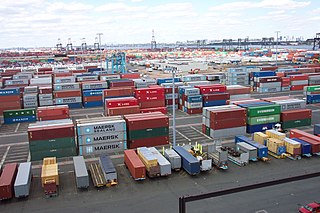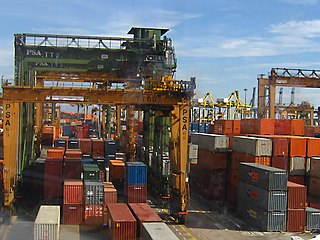
Containerization is a system of intermodal freight transport using intermodal containers. Containerization, also referred as container stuffing or container loading, is the process of unitization of cargoes in exports. Containerization is the predominant form of unitization of export cargoes today, as opposed to other systems such as the barge system or palletization. The containers have standardized dimensions. They can be loaded and unloaded, stacked, transported efficiently over long distances, and transferred from one mode of transport to another—container ships, rail transport flatcars, and semi-trailer trucks—without being opened. The handling system is mechanized so that all handling is done with cranes and special forklift trucks. All containers are numbered and tracked using computerized systems.

Intermodal freight transport involves the transportation of freight in an intermodal container or vehicle, using multiple modes of transportation, without any handling of the freight itself when changing modes. The method reduces cargo handling, and so improves security, reduces damage and loss, and allows freight to be transported faster. Reduced costs over road trucking is the key benefit for inter-continental use. This may be offset by reduced timings for road transport over shorter distances.

In transportation, freight refers to goods conveyed by land, water or air, while cargo refers specifically to freight when conveyed via water or air. In economics, freight refers to goods transported at a freight rate for commercial gain. The term cargo is also used in case of goods in the cold-chain, because the perishable inventory is always in transit towards a final end-use, even when it is held in cold storage or other similar climate-controlled facilities, including warehouses.

A ferry slip is a specialized docking facility that receives a ferryboat or train ferry. A similar structure called a barge slip receives a barge or car float that is used to carry wheeled vehicles across a body of water.

The Port of Miami, styled as PortMiami and formally known as the Dante B. Fascell Port of Miami, is a major seaport located in Biscayne Bay at the mouth of the Miami River in Miami, Florida. It is the largest passenger port in the world and one of the largest cargo ports in the United States.

A swap body, exchangeable container or interchangeable unit, is one of the types of standard freight containers for road and rail transport.

New York New Jersey Rail, LLC is a switching and terminal railroad that operates the only car float operation across Upper New York Bay between Jersey City, New Jersey and Brooklyn, New York. Since mid-November 2008, it has been owned by the Port Authority of New York and New Jersey, which acquired it for about $16 million as a step in a process that might see a Cross-Harbor Rail Tunnel completed.

Rail freight transport is the use of railways and trains to transport cargo as opposed to human passengers.
Truckload shipping is freight transport in which a semi-trailer or intermodal container is filled entirely with one type of cargo. It differs from less-than-truckload shipping (LTL) in which freight from multiple customers is combined in one trailer. A truckload carrier is a trucking company that contracts entire trailer-load to a single customer.

A freight rate is a price at which a certain cargo is delivered from one point to another. The price depends on the form of the cargo, the mode of transport, the weight of the cargo, and the distance to the delivery destination. Many shipping services, especially air carriers, use dimensional weight for calculating the price, which takes into account both weight and volume of the cargo.

A container port or container terminal is a facility where cargo containers are transshipped between different transport vehicles, for onward transportation. The transshipment may be between container ships and land vehicles, for example trains or trucks, in which case the terminal is described as a maritime container port. Alternatively, the transshipment may be between land vehicles, typically between train and truck, in which case the terminal is described as an inland container port.

The Port of Haifa is the largest of Israel's three major international seaports, the others being the Port of Ashdod, and the Port of Eilat. Its natural deep-water harbor operates all year long and serves both passenger and merchant ships. It is one of the largest ports in the eastern Mediterranean in terms of freight volume and handles about 30 million tons of cargo per year. The port employs over 1,000 people, rising to 5,000 when cruise ships dock in Haifa. The Port of Haifa lies north of Haifa's downtown quarter on the Mediterranean and stretches to some three kilometres along the city's central shore with activities ranging from military, industrial, and commercial next to a nowadays-smaller passenger cruising facility.

Drayage is the transportation of shipping containers by truck to its final destination. Drayage is often part of a longer overall move, such as from a ship to a warehouse. Some research defines it specifically as "a truck pickup from or delivery to a seaport, border point, inland port, or intermodal terminal with both the trip origin and destination in the same urban area". Port drayage is the term used when describing short hauls from ports and other areas to nearby locations. It can also refer to the movement of goods within large buildings such as convention centers. Drayage is a key aspect of the transfer of shipments to and from other means of transportation. The term drayage is also used for the fee paid for such services.
The Virginia Port Authority (VPA) is an autonomous agency of the Commonwealth of Virginia that owns The Port of Virginia, a group of facilities with their activity centered on the harbor of Hampton Roads, Virginia.

The Port of Montreal Railway is a terminal railroad operating in Montreal, Canada.

From the start of railroading in America through the first half of the 20th century, New York City and Long Island were major areas for rail freight transportation. However, their relative isolation from the mainland United States has always posed problems for rail traffic. Numerous factors over the late 20th century have caused further declines in freight rail traffic. Efforts to reverse this trend are ongoing, but have been met with limited success.
A Terminal Operating System, or TOS, is a key part of a supply chain and primarily aims to control the movement and storage of various types of cargo in and around a port or marine terminal. The systems also enables better use of assets, labour and equipment, plan workload, and receive up-to-date information.

ExpressRail is a network of on- or near-dock rail yards supporting intermodal freight transport at the major container terminals of the Port of New York and New Jersey. The development of dockside trackage and rail yards for transloading has been overseen by the Port Authority of New York and New Jersey, which works in partnership with other public and private stakeholders. As of 2019, four ExpressRail facilities were in operation, with a total built capacity of 1.5 million lifts.

Cikarang Dry Port (CDP) is a dry port in Kota Jababeka of the town of Cikarang, West Java, Indonesia. With a total area of 200 hectares, CDP was founded in 2010. It is operated as Indonesia's first and only Integrated Customs Services Zone by PT Cikarang Inland Port, a division of the publicly traded PT Jababeka Tbk. As an inland dry port model, CDP acts as a port extension, that addresses ongoing traffic jams and delays at Tanjung Priok, a significant import/export gateway. The primary goal is to reduce the dwelling time from 3.2 days to the government-mandated 2.5 days.

A container chassis, also called intermodal chassis or skeletal trailer, is a type of semi-trailer designed to securely carry an intermodal container. Chassis are used by truckers to deliver containers between ports, railyards, container depots, and shipper facilities, and are thus a key part of the intermodal supply chain.
















